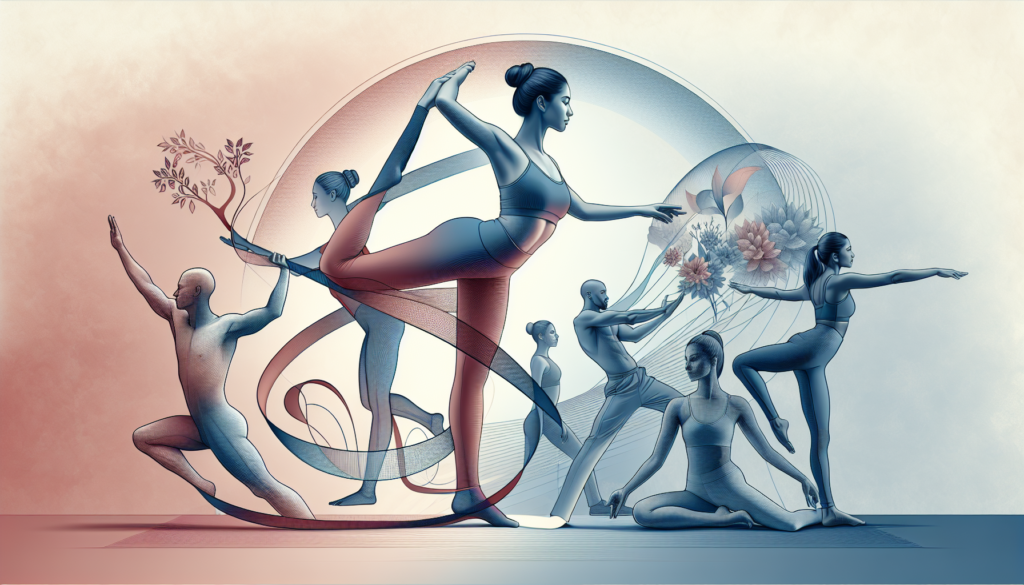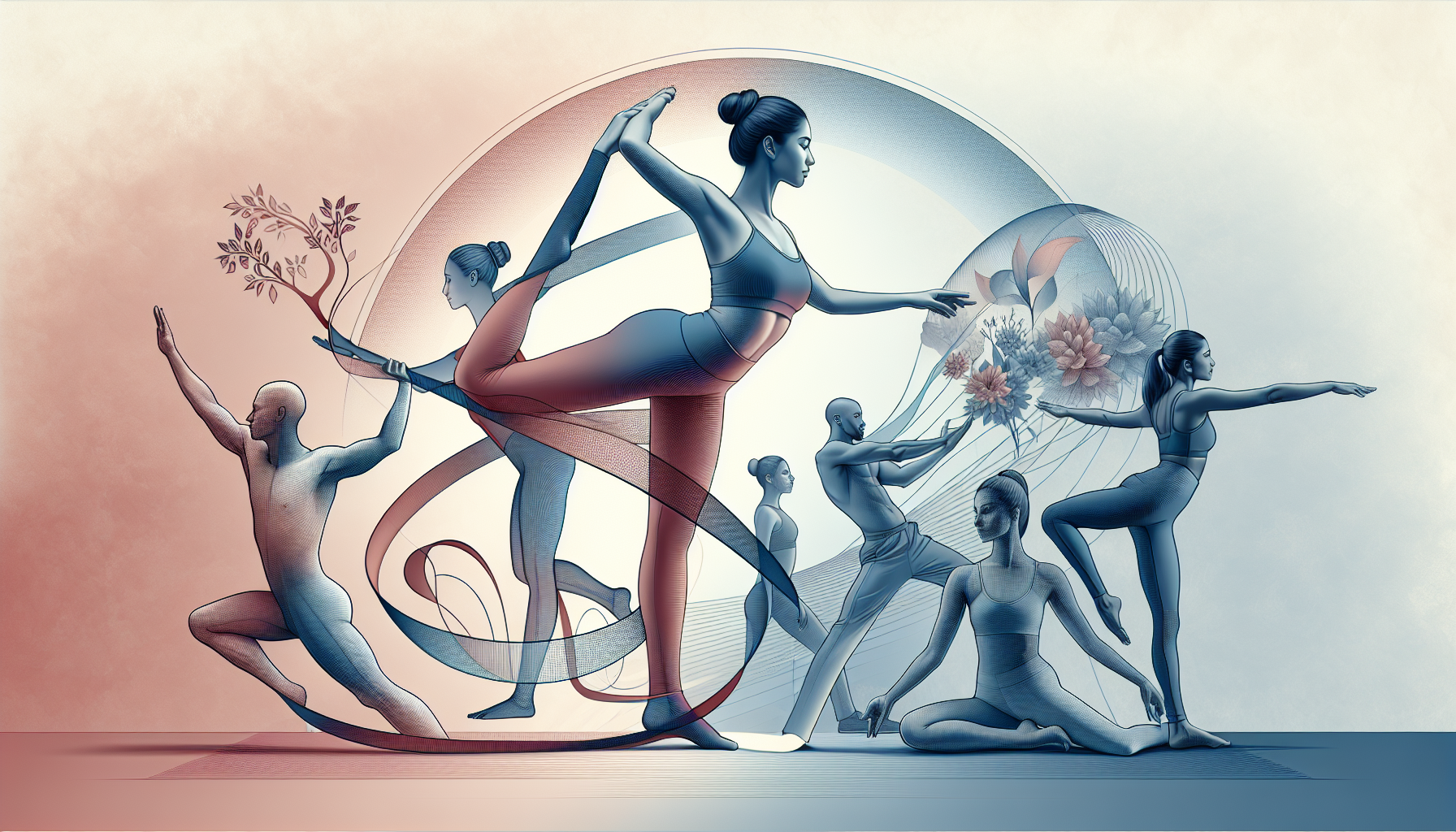If you’re looking to improve your flexibility and prevent injuries, you’ve come to the right place. In this article, we will explore some of the top ways to enhance your flexibility and safeguard yourself from potential injuries. From incorporating dynamic stretches into your routine to practicing yoga and increasing your range of motion, these methods will help you achieve a more supple body and reduce the risk of getting hurt. So, let’s get started on your journey to improved flexibility and injury prevention!
1. Stretching
Stretching is a crucial aspect of any fitness routine as it helps improve flexibility and prevent injuries. There are various types of stretching techniques that you can incorporate into your workouts.
1.1 Dynamic stretching
Dynamic stretching involves moving parts of your body through a full range of motion. This type of stretching helps to increase blood flow and warm up your muscles before physical activity. Examples of dynamic stretches include leg swings, arm circles, and torso twists. Incorporating dynamic stretching into your warm-up routine can prepare your muscles for the workout ahead and help prevent strains or tears.
1.2 Static stretching
Static stretching involves holding a stretch for a certain period, usually around 30 seconds, without any bouncing or movement. This type of stretching helps to improve flexibility and elongates the muscles. Static stretching is best done after a workout or physical activity when the muscles are warm and more pliable. It can also be beneficial to perform static stretching as part of your cooldown routine. Examples of static stretches include hamstring stretches, calf stretches, and shoulder stretches.
1.3 Active Isolated stretching
Active Isolated stretching (AIS) involves holding a stretch for a shorter duration of time, usually around 2 seconds, and repeating the stretch several times. This type of stretching helps to increase range of motion, improve muscle flexibility, and enhance overall mobility. AIS is often used by athletes and can target specific muscle groups. It is important to maintain proper form and perform the stretches in a controlled manner to prevent injury.
2. Incorporating Yoga
Yoga is a holistic practice that combines physical postures, breathing exercises, and meditation. It is an excellent way to improve flexibility, build strength, and enhance overall well-being.
2.1 Sun Salutations
Sun Salutations, also known as Surya Namaskar, are a series of flowing yoga poses that create a fluid movement and help warm up the entire body. This sequence is often performed at the beginning of a yoga practice to awaken the muscles and prepare them for deeper stretches. Sun Salutations involve a combination of forward bends, lunges, and backward bends, providing a full-body stretch.
2.2 Standing Forward Bend
The Standing Forward Bend, or Uttanasana, is a yoga pose that targets the hamstrings, calves, and lower back. This stretch not only helps to improve flexibility but also promotes relaxation and releases tension in the body. To perform the Standing Forward Bend, stand with your feet hip-width apart, hinge forward from the hips, and let your torso hang over your legs. Hold the position for a few breaths and gradually deepen the stretch over time.
2.3 Triangle Pose
Triangle Pose, or Trikonasana, is a standing yoga posture that stretches the legs, hips, and spine. This pose helps to improve flexibility in the hamstrings, groin, and hips while also strengthening the legs and core muscles. To practice Triangle Pose, stand with your feet wide apart, extend your arms parallel to the floor, and hinge at the hip to reach your front hand toward your ankle or a block. Keep your other hand raised toward the sky, creating a straight line with your body.

3. Pilates
Pilates is a low-impact exercise method that focuses on core strength, flexibility, and overall body awareness. Incorporating Pilates exercises into your fitness routine can help improve flexibility and prevent injuries by targeting specific muscle groups and promoting balanced muscle development.
3.1 Leg Circles
Leg Circles are a Pilates exercise that targets the hip flexors, hamstrings, and core muscles. This exercise helps to improve hip mobility and increase flexibility in the legs. To perform Leg Circles, lie on your back with your legs extended. Lift one leg off the ground and draw circles in the air with your toes, making sure to keep your hips stable and your core engaged. Repeat the circles in both clockwise and counterclockwise directions.
3.2 Spine Stretch Forward
Spine Stretch Forward is a Pilates exercise that stretches the muscles along the spine and promotes flexibility in the back and hamstrings. This exercise also helps to improve posture and enhance overall spinal mobility. To practice Spine Stretch Forward, sit tall with your legs extended and slightly wider than hip-width apart. Inhale to lengthen your spine, then exhale as you gently fold forward, reaching your hands towards your feet or shins. Keep your shoulders relaxed and maintain a slight curve in your lower back.
3.3 Swan
Swan is a Pilates exercise that strengthens the muscles in the back, shoulders, and core while also improving spinal mobility and flexibility. This exercise is particularly beneficial for individuals who spend long periods sitting or working at a desk. To perform Swan, lie on your stomach with your hands placed under your shoulders. Press through your hands as you lift your upper body off the ground, arching your spine and extending your arms. Keep your gaze forward and engage your core muscles. Lower back down with control.
4. Foam Rolling
Foam rolling, also known as self-myofascial release, is a technique that uses a foam roller to target tight muscles and release tension. Foam rolling can aid in improving flexibility, preventing muscle imbalances, and reducing the risk of injuries.
4.1 Upper Back Roll
The Upper Back Roll targets the muscles of the upper back, including the trapezius, rhomboids, and erector spinae. This exercise helps to relieve tension and improve flexibility in the upper back and shoulders. To perform the Upper Back Roll, place the foam roller beneath your upper back, supporting your head with your hands. Gently roll up and down, focusing on any tight or tender areas. Breathe deeply and relax into the pressure.
4.2 IT Band Roll
The IT Band Roll targets the iliotibial (IT) band, a thick band of fascia that runs along the outside of the thigh. Rolling the IT band can help alleviate tightness and improve flexibility in the hip and knee joints. To perform the IT Band Roll, lie on your side with the foam roller positioned beneath your hip. Use your top hand and foot to stabilize your body as you roll along the length of the IT band, from the hip to the knee. Adjust the pressure as needed and repeat on the other side.
4.3 Glute Roll
The Glute Roll targets the gluteal muscles, including the gluteus maximus and gluteus medius. This exercise helps to release tension and improve flexibility in the hips and buttocks. To perform the Glute Roll, sit on the foam roller with one ankle crossed over the opposite knee. Lean to one side, putting pressure on the gluteal muscles, and roll back and forth. Focus on any areas of tightness or discomfort. Switch to the other side and repeat.

5. Strengthening Exercises
In addition to stretching and flexibility exercises, strengthening exercises play a crucial role in preventing injuries. Strengthening the muscles surrounding your joints provides stability and support, reducing the risk of strains and sprains.
5.1 Plank Variations
Plank variations, such as the traditional plank, side plank, and forearm plank, target the core muscles, including the abdominals, obliques, and lower back. Strong core muscles help to stabilize the spine and pelvis, reducing the risk of lower back injuries. To perform a plank, start in a push-up position with your hands shoulder-width apart and your body in a straight line. Keep your core engaged and hold the position for as long as you can maintain proper form.
5.2 Bridge Pose
Bridge Pose targets the glutes, hamstrings, and lower back muscles. This pose helps to strengthen the posterior chain, which is essential for maintaining proper alignment and preventing injuries in the lower back and hips. To practice Bridge Pose, lie on your back with your knees bent and feet flat on the ground. Press through your heels as you lift your hips off the ground, squeezing your glutes. Hold the pose for a few breaths and then slowly lower back down.
5.3 Squats
Squats are a compound exercise that targets multiple muscle groups, including the quadriceps, hamstrings, glutes, and core. This exercise helps to strengthen the lower body, improve stability, and prevent injuries in the knees and hips. To perform a squat, stand with your feet hip-width apart. Lower your body down as if you were sitting back into a chair, keeping your knees in line with your toes. Keep your chest lifted, engage your core, and press through your heels as you return to a standing position.
6. Proper Warm-Up
A proper warm-up is essential to prepare your body for physical activity, increase blood flow, and reduce the risk of injuries. It should include cardiovascular warm-up exercises, dynamic warm-up exercises, and joint mobilization exercises.
6.1 Cardiovascular warm-up
A cardiovascular warm-up raises your heart rate and increases blood flow to your muscles. You can achieve this through activities such as brisk walking, jogging, jumping jacks, or cycling. Aim for at least 5-10 minutes of moderate-intensity cardiovascular exercise to warm up your body before stretching or engaging in more intense physical activity.
6.2 Dynamic warm-up exercises
Dynamic warm-up exercises involve moving your body through a full range of motion. This type of warm-up helps to improve flexibility, increase joint mobility, and activate the muscles you will be using during your workout. Examples of dynamic warm-up exercises include arm circles, leg swings, high knees, and bodyweight lunges. Perform each exercise for 10-15 repetitions or as instructed by a fitness professional.
6.3 Joint mobilization exercises
Joint mobilization exercises focus on gently moving and lubricating the joints to improve their range of motion and prepare them for physical activity. These exercises can include wrist circles, shoulder rolls, ankle rolls, and neck stretches. Perform each joint mobilization exercise slowly and smoothly, paying attention to any areas of tightness or discomfort.
7. Regular Massage Therapy
Regular massage therapy can be a valuable tool in improving flexibility and preventing injuries. Massage helps to release muscle tension, increase circulation, and promote relaxation. There are different types of massages that you can try based on your preferences and needs.
7.1 Swedish Massage
Swedish massage is a gentle, full-body massage that uses long strokes, kneading, and circular motions to relax the muscles and promote overall well-being. This type of massage can help to improve flexibility by reducing muscle tension and increasing blood flow. It can also aid in the recovery process after intense physical activity.
7.2 Deep Tissue Massage
Deep tissue massage focuses on the deeper layers of muscle and connective tissue. This type of massage uses slower, more forceful strokes to target specific muscle knots or areas of chronic muscle tension. Deep tissue massage can help to release tightness, improve flexibility, and relieve pain associated with muscle imbalances or overuse injuries.
7.3 Sports Massage
Sports massage is specifically designed for athletes and individuals engaging in regular physical activity. It combines techniques from Swedish massage, deep tissue massage, and stretching to help improve flexibility, prevent injuries, and enhance performance. Sports massage can be customized based on the specific needs and goals of the individual.
8. Balanced Diet
Maintaining a balanced diet is essential for overall health, including flexibility and injury prevention. Proper nutrition provides the body with the necessary nutrients to repair and build tissues, support muscle function, and maintain optimal energy levels.
8.1 Consuming antioxidants and anti-inflammatory foods
Incorporating antioxidants and anti-inflammatory foods into your diet can help reduce inflammation and promote recovery. Foods rich in antioxidants include berries, leafy green vegetables, nuts, and seeds. Anti-inflammatory foods include fatty fish like salmon, turmeric, ginger, olive oil, and green tea. These foods can help to support the health of your muscles and joints, reducing the risk of injuries.
8.2 Adequate protein intake
Protein plays a crucial role in muscle repair and development. Consuming adequate protein can help support muscle recovery after physical activity and promote healthy muscle function. Good sources of protein include lean meats, fish, poultry, eggs, dairy products, legumes, and plant-based protein sources such as tofu and quinoa. Aim to include a variety of protein-rich foods in your diet to meet your body’s needs.
8.3 Staying hydrated
Proper hydration is essential for maintaining overall health and supporting flexibility. Dehydration can lead to muscle cramps, stiffness, and decreased athletic performance. Make sure to drink enough water throughout the day, especially before, during, and after physical activity. If you engage in intense workouts or exercise in hot conditions, you may need to consume electrolyte-rich beverages to replenish lost fluids and minerals.
9. Hygiene and Rest
Maintaining proper hygiene and getting sufficient rest are often overlooked aspects of injury prevention. Taking care of your body and allowing it to recover adequately can help prevent overuse injuries and promote overall well-being.
9.1 Proper hygiene practices
Practicing good hygiene is important to prevent the spread of germs and reduce the risk of infections. Make sure to clean and disinfect any equipment or surfaces you use during your workouts, such as exercise mats, weights, or gym machines. Also, remember to wash your hands thoroughly before and after exercise to minimize the risk of contracting illnesses.
9.2 Getting sufficient sleep
Sleep is a critical component of the body’s recovery process. During sleep, the body repairs damaged tissues, synthesizes hormones, and restores energy levels. Lack of sufficient sleep can impair muscle recovery, increase the risk of injuries, and negatively impact overall performance. Aim for 7-9 hours of quality sleep each night to support your body’s healing and rejuvenation processes.
9.3 Taking rest days
Rest days are essential for preventing overuse injuries and allowing your body to recover from intense physical activity. Incorporate scheduled rest days into your fitness routine to give your muscles time to repair and rebuild. Additionally, listen to your body and take additional rest days as needed if you experience excessive fatigue, persistent muscle soreness, or other signs of overtraining.
10. Listening to Your Body
One of the most important ways to improve flexibility and prevent injuries is by listening to your body and responding to its needs. Each person’s body is unique, and understanding your limitations and boundaries can help you avoid pushing yourself too far.
10.1 Paying attention to pain or discomfort
Pay attention to any pain or discomfort that you may experience during exercise or stretching. Pain is your body’s way of signaling that something is wrong. If you feel sharp or intense pain, it is important to stop the activity and assess the situation. Pushing through pain can lead to further injury. If pain or discomfort persists, consult a healthcare professional for appropriate guidance and treatment.
10.2 Modifying exercises when necessary
It is essential to modify exercises or stretches when necessary to ensure they are safe and suitable for your body. If you are unable to perform a particular exercise or stretch due to flexibility limitations or discomfort, find alternative options or variations that target the same muscle groups. Working with a qualified fitness professional can help you identify appropriate modifications to meet your individual needs.
10.3 Seeking professional guidance if needed
If you are unsure about proper form, technique, or which exercises are most beneficial for your goals, consider seeking professional guidance. A certified personal trainer, physical therapist, or experienced yoga instructor can provide expertise and tailored advice to help you improve flexibility and prevent injuries. They can also create a personalized program that addresses your specific needs and fitness level.
In conclusion, improving flexibility and preventing injuries requires a multi-faceted approach. Incorporating stretching, yoga, Pilates, foam rolling, strengthening exercises, proper warm-up, regular massage therapy, a balanced diet, hygiene and rest, and listening to your body are all essential components of an effective injury prevention strategy. By implementing these practices into your fitness routine and lifestyle, you can enhance flexibility, reduce the risk of injuries, and support your overall well-being. Remember to consult with healthcare professionals or fitness experts to ensure that you are performing exercises correctly and receiving appropriate guidance.
